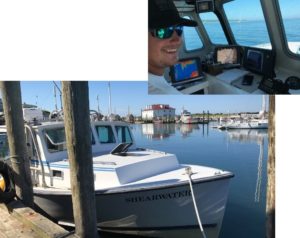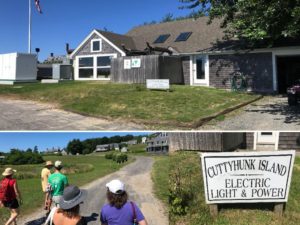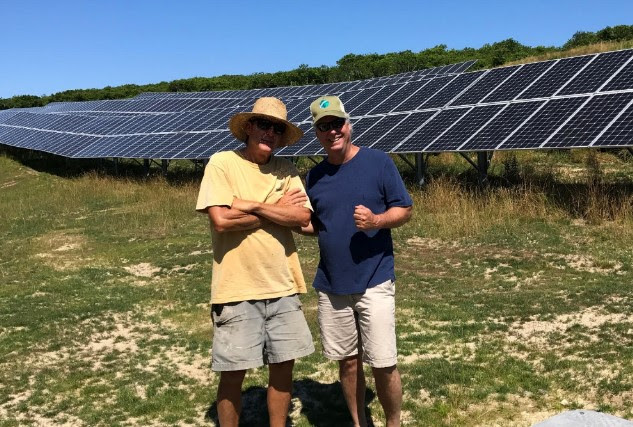Visiting the Cuttyhunk Microgrid

Transportation to Cuttyhunk Island
Just behind Larsen’s fish market in Menemsha we meet… on the docks where seasoned fishing boats unload their catches. Tucker fires up the Shearwater’s mighty diesel engines. He’s our captain for the day. The boat rattles and roars, a 34-foot commercial fishing vessel that reeks of fish. No messing around: It has an eight-foot tailgate to bring in lobster pots and big catches. It’s old and weathered many high seas, and thousands and thousands of pounds of fish.
This is easy duty for our captain, a young man with a wide grin who loves his summer job on board the Shearwater. In the off-season, he’s at a maritime academy and makes very clear his great love of fishing, both commercially and for charters. This is an early morning crossing… heading out of Menemsha, across the Vineyard Sound, through a channel in the Elizabeth Islands, and south to Cuttyhunk… our destination.
The trip takes an hour. Clear sailing: The seas are relatively calm; sun is shining strong. Over the roar of the engines, Tucker shows me the boat’s navigation – its autopilot. But he’s careful and at the helm, noting the recent ferry crash in Hyannis. He navigates his three monitors and shows me maps of subseas; pointing out canyons on the sea floor that channel currents rich with nutrients to the surface, attracting larger fish, and in turn fishermen eager for rich harvests.
After an hour of deafening racket, Tucker eases off the throttle, and we slide past the Cuttyhunk breakwater and into the idyllic harbor alive with boaters of all kinds. We’re on schedule and our host, Wyatt Garfield, waves from the dock.
Cuttyhunk, the site of a converted microgrid. For years, the island has been powered by diesel generators. Some 40 years ago, the diesel-only microgrid was augmented by wind. That’s long gone. Today power costs 60 cents per kilowatt hour on the island. But the population has never justified an undersea power cable – like the one that serves Martha’s Vineyard – and diesel is brought in by boat like everything else. A water taxi comes 14 miles in from New Bedford daily in summer, infrequently in winter.

Cuttyhunk is 500 acres in size. Today about three-quarters of the island is owned by one family, descendants of the Wood family. The Woods owned American Woolen, a textile company that operated 60 mills in eight states, and began purchasing land on Cuttyhunk in 1905, buying two large parcels and building a summer residence. They financed the town sewer system and were widely seen as a steward of the land.
It was in that capacity that a descendant of the Woods named Allen Spaulding spearheaded the construction of a wind turbine on Cuttyhunk in the 1970s. The world at the time was in the grip of the OPEC oil embargo and prices for diesel fuel had doubled. Spaulding’s idea was to augment the diesel power generator with wind, in fact, the largest system in the country at that time.
The wind turbine was built by Wind Turbine Generator (WTG) Energy Systems in 1975. It was mounted on a 25-meter lattice tower, had a 10-meter diameter rotor with stall flaps at the tips, and it was upwind facing. Cuttyhunk was on the map! Cuttyhunk had one of the world’s first wind/diesel microgrid systems.
According to the story, Spaulding left a career as an artist to become president of WTG. But the turbine did not prove reliable, there were claims of radio interference and disturbing resonant sounds, low frequency acoustic impules” that made people feel nautious and dizzy, not to mention the irritation and headaches. So the last of a series of three turbines were taken down, and the island reverted to its diesel generators. In 2013, Spaulding died in a plane crash on the island as he was taking off from his private airfield on Cuttyhunk.
Currently, there are 174 electric meters on the island, serving a summer population of about 250, with a year-round population of less than 50. And it gets cold and dark in the winter. Peak demand on the island is ~250 kW. That’s when most residents are here in summer, the single hotel is busiest, and the bustling port provides shore power for yachts that tie up in the harbor’s slips.
Wyatt is island calm. He meets us at the fishing dock where we also meet his fellow electric power commissioner. It’s a busy morning for the microgrid; a technician from Princeton Power is just arriving to reprogram the system’s controls. We’ll chat with them later.
It’s a family energy tour, Flanigan-style! There are six of us, two daughters, a brother, nephew and his wife… all Flanigans. Wyatt walks at a brisk pace from the pier to the site of the Cuttyhunk electric system… a very small facility. Some kind of glitch has a back-up diesel generator working unnecessarily. And that’s after a record eight days of no diesel back-up at all, in the height of summer. Cuttyhunk’s microgrid is well designed, and providing for summer peak use using solar plus storage.
Today, Cuttyhunk features a carbon-free microgrid, with diesel back-up, an enviable configuration. Thanks to a U.S. Department of Agriculture grant, Cuttyhunk was awarded a $2.1 million grant to convert its power system from 100% diesel to carbon-free. The island community only had to pay a $160,000 shortfall price. With saved fuel costs the system will likely pay for itself in just a few years. After that, notes Wyatt, his commission expects to be able to lower the kWh cost for island residents.
We walk into the unassuming “power plant” where the island has housed four diesel generators for some time. Fuel for power has been the community’s third largest expense. So efforts have been made to conserve. Years ago everyone was encouraged to replace inefficient refrigerators; more recently there was a push to convert home’s to LED lighting. These concerted efforts have reduced loads and enabled the carbon-free microgrid.

Our posse heads up to the solar system, a 350 kW ground-mounted system tucked away in an unobtrusive spot. The array is impressive; there’s a stack of SolarWorld panels to the side; no need for security here on this remote island. We check the racking, combiner, the inverter… The system was energized in April of this year, the system generating power that feeds the microgrid and its 1.25 MWh battery storage system. The system was built on private property; the community pays the landowner $1,800 a month for the use of the site.
As we stroll our guide and ambassador points out the island’s features; he tells us that he retired from a career in retail in Maine. He now spends entire summers in Cuttyhunk with his wife and visiting children and grandchildren. He’s building a new home here and the windows just were shipped in.
We get back to the power system. A dilemma facing the utility is excess solar power in winter and potentially shoulder seasons. This is not net energy metering country! There is no power grid, no ISO, to address seasonal variations in generation and use. We chat about resistance heating, heat pumps, perhaps electrolysis and hydrogen production… ways of using the excess without fostering wasteful habits. Solar was considered best since production maxes in summer when it’s needed the most. Wind, on the other hand, would have been prolific year-round.
Cuttyhunk has a one-room schoolhouse, and church that Wyatt point out. He recounts with a sparkle in his eye that he was married there some years ago. There’s a museum, a few restaurants. We buy lemonade from kids outside the island’s sole market. As we walk the community, we see transformers that knock down the microgrid’s voltage from 480 to 220 volts for household use.
Wyatt has been most generous with his time. We thank him heartily. Now he’s got to get back to his wife and grandchildren. He points out the road to the best viewing spot on the island, Lookout Hill. Go up there he said and we did. It couldn’t have been more post-card perfect. With 360-degree views where we snap many photos, then head down to the marina and wrap our micro-island experience at its raw-bar on the pier, oysters, stuffed scallops, and chowder.
We’re pretty quiet on the way back. The engine roars, the boat rattles and pounds its way through the seas. We’re all imagining island life, or what it takes to be an islander… day in and day out. And then I chat with Tucker – we’re on cruise control and he wants to talk fish again. Imagine. Nothing like getting your limit of stripers!
